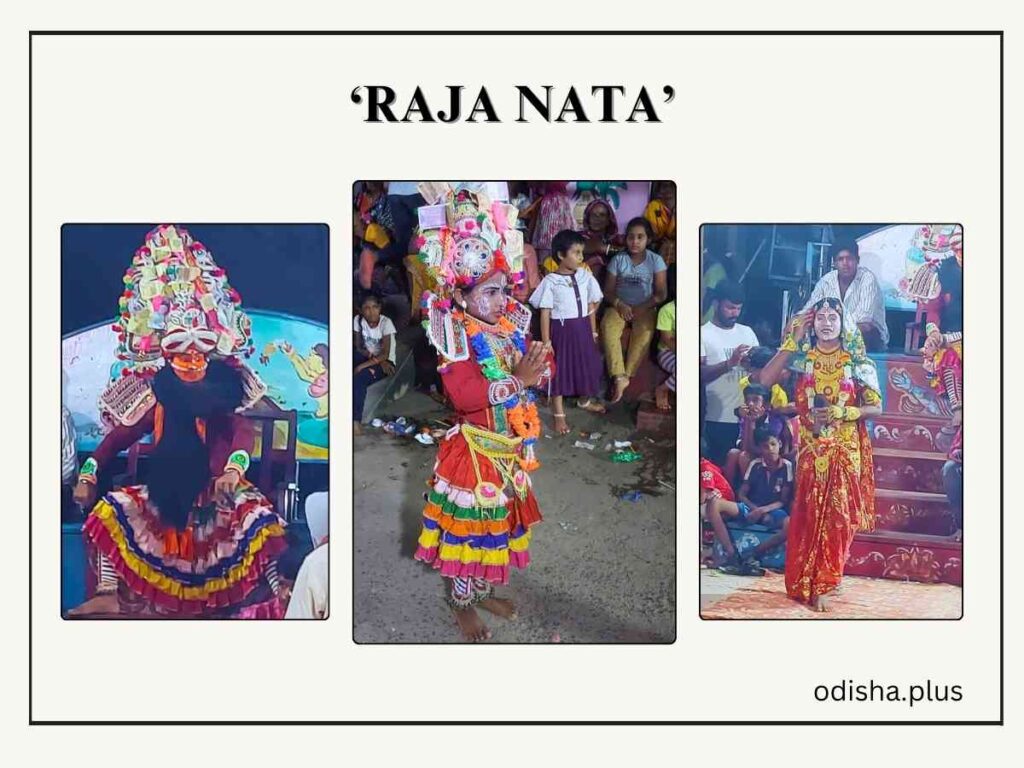A ‘Duel’ performance of ‘Prahlad Natak’ took place in Gobindpur village, Odisha
Kapilas Bhuyan

Last week I had accompanied senior-most artist friend Ramahari Jena to Berhampur who has been doing his research and documentation as a Tagore Fellow on the folk traditions of Ganjam district. On Saturday evening around 6 pm we got information that a ‘badi’ or ‘duel’ performance of ‘Prahlad Natak’, popularly known as ‘Raja Nata’ was taking place in Gobindpur village under Chhatrapur block.
The show had been on since 10 am in the morning and would continue until midnight. We decided to move and catch up the performance. We were accompanied by Alok Bishoyi, a folk performer of the district and Bayamanu Charchi, an author devoted to writing about the folk culture of South Odisha.
It took about 45 minutes drive from Berhampur to reach Gobindpur after negotiating frequent hairpin curvatures from the highway. A youngman was waiting for us to guide our way to the spot of the performance. It was a narrow village street of about 80 meter long amid the living quarters. The whole length of the street was divided by tying a bamboo horizontally covering the width of about 12 ft. and thus demarcating the space of the performance.
While on one end Tapas Pradhan’s troupe was performing, on the other end Durgacharan Sahu was enacting the character of King Hiranya Kashyapu. The villagers including women and children were witnessing the performance from both sides comfortably sitting on their own verandahs. It was very heartening to observe that in the era of mobile phones that keeps engaged everyone peeping onto its small screen for entertainment, the folk performance had not lost its charm.
In ‘Raja Nata’, as the story is drawn from the mythology regarding the Nrusingha Avatar, one of the 10 avataras of Lord Vishnu, the content is known to almost all the villagers. So, what they witness as the audience of this open-air performance is the level of enactment of the artists, in performing various characters and their capacity to transform themselves into the characters they are playing.
What matters the most to the success of the performance is always considered on the basis of performance of King Hiranya Kashyapu and Prahlad. Whereas the Shaivite King Hiranya Kashyapua, the father wants his son Prahlad to be a follower of Lord Shiva, Prahlad as an ardent follower of Lord Vishnu disobeys his father. This angers the King Hiranya Kashyapu. But Prahlad in his simple and innocent way declines to obey despite his father’s life-threatening commands. Queen Lilabati, wants to give a cover to her son but fails – neither the King, nor her son Prahlad give any heed to her words.
(The King Hiranya Kashyapu was given a boon by Lord Shiva that no one could kill him either inside his palace or outside, and neither on the ground nor in the space above. Thus, he had this idea of power to rule for ever and had been ever obliged to Lord Shiva.)
During the performance of ‘Prahlad Natak’ the King threatens Prahlad with dire consequences with all his might laced with Vira Rasa which enhances his character, and every time while Prahlad declines to obey his order he gets into unheeded rage of utter helplessness that gets reflected in the performance. The villagers enjoy it if the actor enacts it well. That’s why perhaps this folk performance is popularly called ‘Raja Nata’.
At the pick of his rage when King Hiranya wants to kill Lord Vishnu after asking Prahlad whether he exists even in the nearby pillar and when Prahlad confirms it, he breaks the pillar to prove Prahlad wrong – alas! there appears the Avatar of Nrusingha and putting him on his lap kills him on the threshold of the palace.
Basically, the performance of ‘Prahlad Natak’ could have evolved at a time of conflict between the Vaishnavites and Shaivites. If not, it might have evolved to narrate the story of the Nrusingha avatar of Lord Vishnu. Whatever might have been the background, the ‘Raja Nata’ or ‘Prahlad Natak’ performance, no doubt, has been integral to the folk performance of Ganjam district since a long time.
The stage is a five-step wooden platform placed at the one end of the village street on which King Hiranya Kashyapu makes his fretful movements. Other important characters enact on the ground of the street. Having a wooden head-gear and thick beard King Hiranya Kashyapu looks demonic and larger than life and covers the whole of stepped wooden platform as well as the ground below by his movement while performing. To enhance his image, he wears a green or dark goggles on his eyes and puts a thick thread under his nose as a moustache. The look of King Hiranya Kashyapu seems to be greatly influenced by various South Indian dance styles.
The speech during enactment is delivered in very heavy baritone with Ganjam accent laden with loud music of different folk instruments. Characters like Lilabati and Shabar-Shabaruni (the hunter and his wife), etc. sing relevant Odia songs based on various Raga and Ragini being supported by the folk musical ensemble sitting in front of the stage to enhance the mood and emotion of the situation.
The most important fact is that ‘Prahlad Natak’ or ‘Raja Nata’ is performed in the open air continuously over 12 to 14 hours in a day, and despite the strain they keep the village audience engaged throughout their performance. Thus, it is never a small feat, and indeed, very challenging for the performers. The challenges get multiplied during a ‘Badi’ performance as the viewers keep comparing the performance standard of both the performing troupes throughout their enactment.
It is to be noted that ‘Prahlad Natak’ or ‘Raja Nata’ is the only folk form of Odisha that remains as an all men-bastion. Even the characters like Lilabati, Shavaruni, etc. are being played by male actors. The performance of Bikash Pradhan as Lilabati in Tapas Pradhan troupe had been very heart rending and liked by the audience. Another typical aspect during the performance of folk dance or theater in South Odisha is that members of the audience simply walk onto the center stage and pin a currency note on the headgear or chest of the performer if they like it.
We were indeed fortunate enough in that evening to witness such a ‘Badi’ performance of ‘Raja Nata’ in Gobindpur, and interestingly, the actors performing as King Hiranya Kashyapu that day, Tapas Pradhan and Durgacharan Sahu are actually dear friends, but were performing as opponents during the ‘duel’ performance. Kudos to both of them as the memory of the event will surely remain for a long time to come.
(The writer is a Senior Journalist and National Award-winning Filmmaker based in Bhubaneswar. Views expressed are personal.)



























